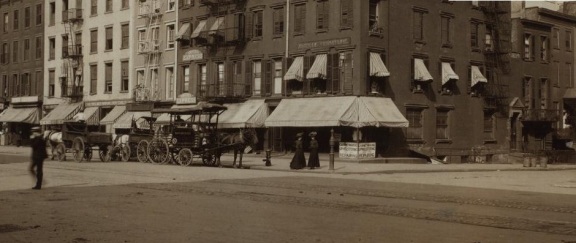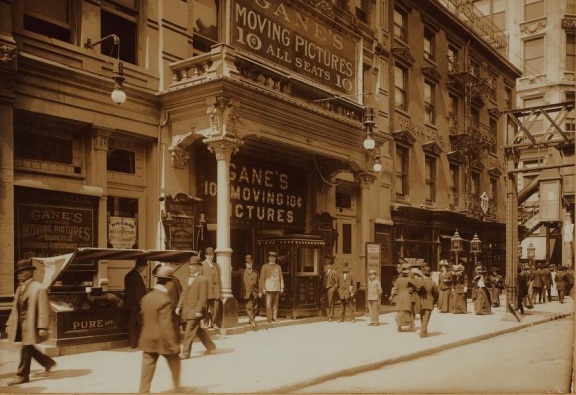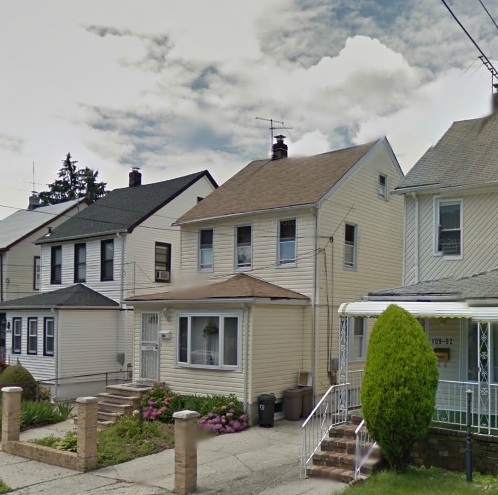For twenty-eight years, Catherine Phelan served the Sheridan household. Catherine, at 52 in 1933, had spent more than half her life in their employ. When Mrs. Sheridan passed away in 1924, Catherine was elevated to the role of live-in maid to the widower Mr. Douglas Sheridan, a 68-year-old stock broker who by all accounts enjoyed a privileged lifestyle. For nine years, Catherine and Mr. Sheridan lived together in his 2-bedroom apartment at The Grinnell, a luxurious apartment block on Riverside Drive at 157th Street in Washington Heights.

Catherine Phelan ca 1934
All signs pointed to theirs being a rather quiet and happy life. Such was his esteem for Ms Phelan, that Mr. Sheridan included her in his will, drafted in 1930, to the tune of $8,000 plus all of the furnishings in the apartment. Yes, all seemed quite well in apartment 2G.
Until the evening of Saturday, December 30, 1933.
Around 2:30 that afternoon, according to court records, Mr. Sheridan was at his office on lower Broadway celebrating the impending New Year by drinking and generally making merry with some of his colleagues, including Miss Isabelle Cullen, along with two men by the names of Young and Eckes. Sometime after 5:00, the foursome plus another unnamed young lady left the office and made their way to the Thames Club, a speakeasy nearby, where the reverie continued.

The Grinnell at 800 Riverside Drive in Washington Heights, pictured here shortly after its construction in 1911. Douglas Sheridan shared an apartment with his live-in maid Catherine Phelan here until 1933.
By 7:00, Eckes and the unnamed lady departed for their respective homes, leaving Sheridan, Young, and Miss Cullen to ride uptown to Sheridan’s Riverside Drive apartment. They arrived around 8:00 and found the maid, Catherine, setting out a dinner for two, as she had expected Miss Cullen for dinner. Little love was lost between Catherine and Isabelle, particularly when the latter brought Mr. Sheridan home as drunk as he was this particular evening.

The 157th Street Subway Station entrance as it would have appeared in on the night that Mr. Sheridan and his friends rode up to his home. Behind the stairs on the left, you can see Liggett Drug Store, where Catherine would later claim to have gone on the night in question.
Catherine, wearing a dark blue dress, stood in the doorway between the living and dining rooms as Mr. Sheridan went to his bedroom and returned with a bottle of Canadian Club whiskey and proceeded to pour three glasses. When Mr. Young left to get a glass of water from the kitchen, Catherine upbraided Miss Cullen, demanding, “What do you mean bringing Mr. Sheridan home in that condition?” She then struck Miss Cullen across the face. In doing so, her arm knocked a large birdcage from its stand, sending it crashing to the floor, whereupon the bird it held escaped and flew about the room.
A drunk Sheridan raised his hand toward Catherine, asking, “What do you mean, Katy, by acting that way toward Miss Cullen?” as Isabelle defended herself to Catherine, insisting that Sheridan had been drinking long before she met up with him. Hearing the commotion, Young returned from the kitchen to find Miss Cullen crying. Upon learning what had transpired, he suggested to Isabelle that she not stay for dinner and instead leave with him.

The floorplan of the Grinnell, here cropped to show units G (Sheridan) and J (Herrick). G is on the left in grey. J is the larger one on the right in white.
Catherine chased down the escaped bird before going to call on their neighbor, Mrs. Herrick, in apartment 2J to ask her to look after the bird while they straightened things out. Afterward, around 9:00, Young and Miss Cullen prepared to leave Sheridan, with the latter bidding him “See you tomorrow,” as they planned to spend New Year’s Eve together. Catherine stood in the doorway as the two guests waited for the elevator and departed. Young hailed a cab and escorted Miss Cullen to her friend Miss Herrin’s apartment at 602 West 165th Street.
Concerned for Mr. Sheridan, Miss Cullen instructed her friend to attempt calling his home, fearing that if Catherine answered, she would hang up on Miss Cullen. They called at 10:05 and received no answer. They tried his number again at 10:15, this time with a woman answering, presumably Catherine: “Just a minute; he went out; let me see if I can get him.” The line went silent, and after about three minutes of waiting Miss Herrin hung up.
Sometime after 11:00, Mrs. Herrick in apartment 2J, adjacent to Sheridan and Catherine’s, heard the bell ring on her service entrance door. Opening it warily, Mrs. Herrick discovered Mr. Sheridan lying on the floor of the hallway outside his apartment door, on his back, clutching his head and moaning. Frightened, Mrs. Herrick closed the service entrance and ran around her hallway to the main entrance, which was closer to the elevator, where she intended to call on the operator to fetch the police. At some point during her run from one door to the other, Mr. Sheridan disappeared from the hallway.

The Grinnell advertised in a catalog, ca 1910
Roughly 10 or 15 minutes later, Mrs. Herrick reported hearing Mr. Sheridan’s pet poodle begin barking and howling, intermingling with the sound of Sheridan’s phone ringing. Miss Cullen and her friend up on 165th Street were trying yet again to get through to his phone. The same woman’s voice answered (presumably Catherine again), telling the girls that Mr. Sheridan was out. Miss Herrin left her number with the woman, insisting that it was “very important” that Mr. Sheridan call her back. “What do you mean, important?” the woman snapped before hanging up the phone.
Sheridan’s poodle continued to bark until nearly midnight. At roughly 12:45, Catherine appeared at the Herricks’ door, proclaiming “that ‘they’ had murdered him.” Mr. Herrick followed Catherine into apartment 2G, where she showed him Mr. Sheridan’s bloodied body lying in the bathtub, still in his pajamas. His head, neck, and chest were covered with lacerations, and parts of his skull had been smashed in. Horrified, and not wanting to get involved, Mr. Herrick refused to call the police, and instead told the elevator operator to call for an officer; that there had been an accident. The operator passed the message along to the building’s night watchman, who ran around the block looking for someone. Unsuccessful, and unaware of the gravity of what had happened, the watchman dropped the subject and returned to his post.
Finally, at 1:31, Catherine phoned the police, stating that there had been “some trouble” in her apartment. By 1:40, officers Costello and Larkin appeared at apartment 2G. “I’m glad you are here. I’ve been waiting for you,” she told the officers. She was no longer wearing the blue dress she’d been in earlier in the evening, instead donning a white dress festooned with black flowers. She led them into the bathroom, where they found Mr. Sheridan’s body, still in the tub, but now fully nude except for a small towel which had been placed over his private parts. Upon realizing that a murder had been committed, Costello and Larkin notified the homicide unit, which sent officers over straight away.
Around 1:45, another officer by the name of Schweitzer was on his way to The Grinnell to help with the investigation. As he approached the massive, triangular building along 157th Street, he discovered lying on the sidewalk a large hammer. It was directly beneath the dining room window of apartment 2G. And it was covered with blood.

New York Times, January 1, 1934
Schweitzer brought the hammer into the apartment and showed the other officers present. Officer Ryan, one of the homicide specialists, lifted the dining room window open, revealing a bundle of blood-soaked clothing hidden on the windowsill. The bundle included the blue dress that Catherine had earlier been wearing along with the yellow pajamas that Mr. Sheridan had been dressed in when Mr. Herrick from apartment 2J came over to investigate.
Dr. Gonzales, the medical examiner, arrived at about 2:30 in the morning. He estimated that Sheridan had been dead only a few hours, and that his body had been very recently cleaned. Large sections of his shoulders and back bore scald marks from overly-hot water being used to rinse him down. Sheridan had sustained some 27 lacerations, including several which had pierced his skull and hit his brain. The wounds matched up with the pronged end of the hammer from the sidewalk.
At 4:00, a female officer was fetched to strip-search Catherine. Her corsette and brassiere were speckled with blood, and flecks of blood dotted the lenses of her glasses. She denied knowing how the blood got on her glasses, and insisted that the blood on her underclothes resulted from her trying to revive Mr. Sheridan when she discovered his body in the tub as she prepared to bathe. On her finger, Catherine wore a substantial and expensive-looking ring, which Mr. Sheridan usually wore on his little finger. She claimed to have found it on the bathroom floor and put it on for safekeeping.

The Costello Theatre at 23 Fort Washington Avenue, where Catherine claimed to have been at the time of the murder. It is today a rather unfortunate-looking church.
Catherine was interrogated for hours, deep into the morning. She refused to admit any wrongdoing, or even any knowledge of what had happened to Mr. Sheridan. She claimed to have left the apartment after her confrontation with Miss Cullen and to have walked to the Costello Theatre, on Fort Washington Avenue at 159th Street, where she stayed until past midnight. When asked what film she saw, she claimed to not remember. When reminded that theatres don’t stay open that late, she claimed to have left it after only a few minutes to wander around the block, before blurting out “I didn’t go to any picture!” She purported to have stopped at the Liggett Drug Store at 157th and Broadway before walking back to the Grinnell. Upon seeing that Mr. Sheridan’s lights were still on, she paced the block, not wanting to see Miss Cullen.
No witnesses came forward to claim to have seen Catherine out walking. Nor did anyone see her at the Costello Theatre. Nor did anyone see her going into Liggett Drug Store.
When asked point-blank if she had killed Mr. Sheridan, Catherine snapped, “How dare you ask me that question? You ask me that again, I will report you to the police commissioner!” When asked again, she retorted smugly, “Find out.”

New York Times, January 11, 1934
Catherine was jailed without bail while awaiting trial. For the next 11 months, she maintained her alibi, but it was of little use. On November 22, 1934, her verdict was handed down: guilty of murder in the second degree.
On December 17th, her sentence was announced to be 20 years to life in prison. “Thanks for the Christmas present,” she snidely replied to the judge. When a police officer grabbed her arm to lead her away, she wrenched it free, snarling, “You don’t have to hold me!”

New York Daily News, December 18, 1934
And with that, Catherine seems to have disappeared into the obscurity of the ages. Not a single article seems to exist documenting her later years, where she ended up in prison, if she was ever released, or when she died. The Grinnell still stands proudly at 800 Riverside Drive. I actually walk by it on my way to the subway every day. Apartment 2G, according to a Google search, was rented out for $2,500/month a couple of years ago. By the looks of the floor plan, it appears that the living room where Catherine slapped Miss Cullen has been closed off and turned into a third bedroom. The dining room where Catherine laid out a dinner table for two is now the living room. Otherwise, little has changed.
I can’t help but wonder if its current residents know what horrors befell apartment 2G on that cold December night in 1933.

The floorplan of apartment 2G as it appears today. Sheridan’s bedroom is on the left, with the bathroom where he died separating it from Catherine’s room.
Update 12/2/2013: Most of the details regarding Catherine’s case were pulled from an appeal of her sentence filed in 1936 and available through Google Books here (link will open a new window). It makes for very interesting reading!
***If anyone has any more information about what happened to Catherine after her sentencing, I’d love to hear about it! Thanks for reading***



















